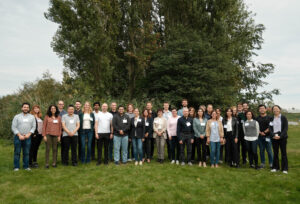
Researchers are trying to create biopolymers from wastewater emissions
Canadian Plastics
Packaging Research & Development SustainabilityThe goal is to electrochemically convert carbon dioxide emissions from water-treatment sludge into PLGA polymers.

A group picture of the HICCUPS consortium. Photo Credit: Avantium N.V.
A four-year research project, called HICCUPS, that aims to transform wastewater into bio-based polymers for packaging applications has been launched by consortium of 12 European companies.
The acronym HICCUPS stands for “highly innovative technology demonstration for bio-based carbon dioxide capture and utilization for production of bulk plastics applications.”
Funded by EU Horizon Europe with a grant of five million euros, the project was launched in September 2023 and will run until the end of August 2027.
The project’s mission is to develop an efficient method for electrochemically converting carbon dioxide emissions from water-treatment sludge into poly lactic-co-glycolic acid (PLGA), which is a polymer that – according to the researchers – has “excellent water and gas barrier properties,” and is fully biodegradable and completely made from renewable feedstock, which makes it a promising candidate for the replacement of fossil polyethylene.
The project’s final products will include PLGA-coated paper for food packaging, and molded plastic.
The consortium carrying out the project consists of 12 partners from seven different countries. Four members are responsible for the CO2 capture and purification process of the CO2 present in the biogas produced during wastewater treatment. They will build a demonstration plant at a wastewater treatment facility in Spain to study the average characteristics of the gas stream produced during the anaerobic digestion of wastewater sludge using consortium member Aqualung’s patented membrane technology. This membrane technology offers versatility and flexibility enabling highly efficient solutions for CO2 separation from various sources, HICCUPS officials said, including flue gas and biogas.
Dutch renewable chemistries manufacturer and project coordinator Avantium will use its one-step electrochemical conversion technology to convert CO2 into oxalic acid, followed by reduction to glycolic acid. It will subsequently polymerise this glycolic acid into the CO2-based polymer, PLGA. During this process step, Avantium will work closely with research partner VTT (Finland), who will be responsible for removing the water from the glycolic acid, enabling the dried glycolic acid to be then polymerised by Avantium.
Two other partners, Walki (Finland) and Tecnopackaging (Spain), both producers of packaging materials, will look at different applications made from PLGA. PLGA packaging materials will be produced and tested at their industrial pilot plants. Walki will carry out both extrusion and wet coating trials on fibre substrates to produce coated paper and board samples. Moreover, the research team on bio-based and green polymers at the University of Ferrara (Italy) will conduct processability research to determine the optimal conditions for the paper coating.
Additional studies, including digital projections, life cycle analyses, biodegradability and recycling studies and a comprehensive business case analysis will be conducted by the University of Amsterdam, Inrae (France) and nova-Institute (Germany). Furthermore, nova-Institute and Avantium will also be responsible for the dissemination, communication, and knowledge transfer of the project, HICCUPS officials said.
